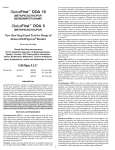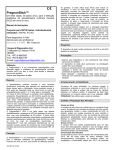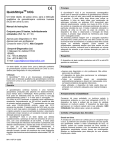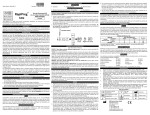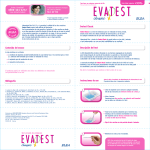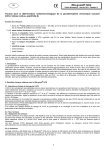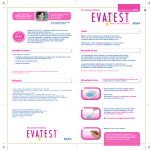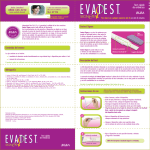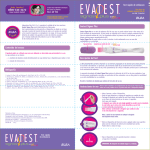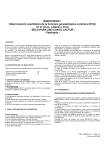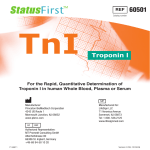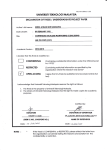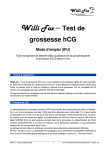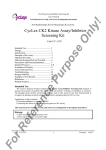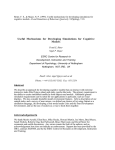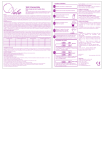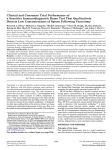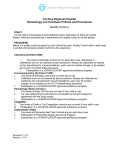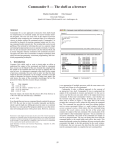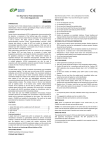Download BioSign hCG CE urine-reader.p65
Transcript
P-51103 Symbols Key Phenothiazine 20 mg/dL Phenylpropanolamine 20 mg/dL Salicylic Acid 20 mg/dL Tetracycline 20 mg/dL Bilirubin 1 mg/dL CE Mark Glucose 2000 mg/dL Authorized Representative Hemoglobin 1 mg/dL Ketones 100 mg/dL ® BioSign hCG Manufactured by In Vitro Diagnostic Medical Device Consult Instructions for Use 1. Braunstein, G.D., Rasor, J., Adler, D., Danzer, H., and Wade, M.E. Serum Human Chorionic Gonadotropin Levels Throughout Normal Pregnancy. Am. J. Obstet. Gynecol. 126:678, 1976. 2. Krieg, A.F. Pregnancy Tests and Evaluation of Placental Function in: Clinical Diagnosis and Management by Laboratory Methods, 16th ed., Henry, J.B. (ed.) W.B. Saunders Co., Philadelphia, pp. 680, 1979. Timer For Professional In Vitro Diagnostic Use Only • External positive and negative controls Precautions 4. Hussa, R.O. Human Chorionic Gonadotropin, A Clinical Marker: Review of its Biosynthesis. Ligand Review 3:6, 1981. Do not reuse Stock No. BSP-121 BSP-121-10 6. Ross, G.T. Clinical Relevance of Research on the Structure of Human Chorionic Gonadotropin. Am. J. Obstet. Gynecol. 129:795, 1977. Transfer Pipette Test Device 10. Braunstein, G.D., Vaitukaitis, J.L., Carbone, P.P., and Ross, G. T. Ectopic Production of Human Chorionic Gonadotropin by Neoplasms. Ann. Inter. Med. 78: 39-45, 1973. 11. Murray, H., Baakdah, H, Bardell, T., and Tulandi, T. Diagnosis and treatment of ectopic pregnancy. CMAJ 173 (8): 905-912, 2005. Principle Pregnancy Test 8. Morrow, C.P., et al. Clinical and Laboratory Correlates of Molar Pregnancy and Trophoblastic Disease. Am. J. Obstet Gynecol. 50:424-430, 1977. 9. Dawood, M.Y., Saxena, B.B., and Landesman, R. Human Chorionic Gonadotropin and its Subunits in Hydatidiform Mole and Choriocarcinoma. Am. J. Obstet. Gynecol. 50: 172-181, 1977. 12. Snyder JA, et al. Diagnostic Considerations in the Measurement of Human Chorionic Gonadotropin in Aging Women. Clin Chem 51: 1830-5, 2005. 14. Steier, J.A., Bergsjo, P., and Myking, O.L. Human Chorionic Gonadotropin in Maternal Plasma After Induced Abortion, Spontaneous Abortion, and Removed Ectopic Pregnancy. Am. J. Obstet. Gynecol. 64:391-394, 1984. 15. Wilcox, A.J., Weinberg C.R., O’Connor J.F., Baird D.D., Schlatterer, J.P., Canfield, R.E., Armstrong E.G., Nisula, B.C., Incidence of early loss of pregnancy, N. Engl. J. Med., 1988; 319: 189-194. Specimens containing particulate matter may give inconsistent test results. Such specimens should be clarified by centrifugation prior to assaying. • Frozen specimens must be completely thawed, thoroughly mixed, and brought to room temperature prior to testing by allowing the specimens to stand at room temperature for at least 30 minutes. • For optimal early detection of pregnancy, a first morning urine specimen is preferred since it generally contains the highest concentration of hCG of the day. However, randomly collected urine specimens may be used. • Collect the urine specimen in a clean glass or plastic cup. Manufactured by Princeton BioMeditech Corporation Princeton, NJ 08543-7139 U.S.A. 1-732-274–1000 www.pbmc.com • BioSign® hCG Test: Each device contains mouse monoclonal and goat anti-hCG antibodies • Disposable dropper • Package insert • If testing will not be performed immediately, the specimens should be refrigerated (2°C to 8°C) for up to 72 hours prior to assay. • For prolonged storage, specimens should be frozen and stored below -20°C. Frozen specimens must be completely thawed, thoroughly mixed before using. Avoid repeated freezing and thawing. • If specimens are to be shipped, they should be packed in compliance with Federal regulations covering the transportation of etiologic agents. Test Procedure Summary The procedure consists of adding the specimen to the sample well in the device, inserting the device into the DXpress™ Reader and following the instructions to get the result. Procedural Notes • Allow the dropper to fill with sample without air bubbles. • Handle all specimens as if capable of transmitting disease. • After testing, dispose of the BioSign® device, and the specimen dispenser following good laboratory practices. Consider each material that comes in contact with specimen to be potentially infectious. Using Dxpress™ Reader Materials Provided 4 Approximately 110 µL of sample is required for each test. • Procedure The BioSign® hCG Test kit contains complete reagent components and materials to perform the test. MT Promedt Consulting GmbH Altenhofstrasse 80 66386 St. Ingbert Germany +49-68 94-58 10 20 • Specimen Storage Reagents © 2000 PBM Printed in U.S.A. Revised Apr 2006 P-51103 0426BL The test device should remain in its sealed pouch until ready for use. Specimen Collection and Preparation The BioSign® hCG Test is a rapid urine test for detecting hCG qualitatively. The test employs a solid-phase, chromatographic immunoassay technology to detect elevated levels of hCG in urine with a high degree of sensitivity. In the test procedure, sample is added to the sample well with a transfer pipette. If hCG is present in the specimen, it will react with the conjugate dye, which binds to the antibody on the membrane to generate a colored line. The DXpress™ Reader interprets the test result automatically by comparing the intensity of the test line to the preset cutoff value. The hCG levels greater than or equal to 25 mIU/mL are reported as positive. Samples containing less than 25 mIU/mL are reported as either negative or borderline. 13. Cole, L.A. Immunoassay of human chorionic gonadotropin, its free subunits and metabolites, Clin Chem 43:12. 2233–2243, 1997. Patent No.: 5,559,041 • 35 Test Kit 10 Test Kit Human chorionic gonadotropin (hCG) is a glycoprotein hormone produced by the placental trophoblastic cells shortly after the implantation of fertilized ovum in the uterine wall.1-4 The primary function of hCG is to maintain the corpus luteum during early pregnancy. The appearance of hCG in urine soon after conception and its rapid rise in concentration make it an excellent marker for confirmation of pregnancy. The hormone can be detected in urine as early as 7 to 10 days after conception.1-4 The concentration of hCG continues to rise rapidly, frequently exceeding 100 mIU/mL by the first missed menstrual period and peaking in the 100,000–200,000 mIU/mL range by 10 to 12 weeks into pregnancy. The hormone is comprised of two non-covalently bound dissimilar subunits containing approximately 30% carbohydrate by weight.5 The alpha subunit is structurally similar to other human pituitary glycoprotein hormones, whereas the beta (ß) subunit confers unique biological and immunological specificity to the molecule.6,7 BioSign® is a Registered Trademark of Princeton BioMeditech Corporation. Do not interchange materials from different product lots and do not use beyond the expiration date. Summary and Explanation Instructions for Use 7. Reuter, A.M., Gaspard, U.J., Deville, J-L., Vrindts-Gevaert, Y. and Franchimont, P. Serum Concentrations of Human Chorionic Gonadotropin and its Alpha and Beta Subunits. 1. During Normal Singleton and Twin Pregnancies. Clin. Endocrinol. 13:305, 1980. • BioSign hCG Test kit is to be stored at 2°C to 30°C (35°F to 86°F) in the sealed pouch. BioSign® hCG Test is a simple immunoassay for the qualitative detection of human chorionic gonadotropin (hCG) in urine for the early confirmation of pregnancy. This test is intended to be used with the DXpress™ Reader. Contents For in vitro diagnostic use only. ® Intended Use 5. Swaminathan, N. and Bahl, O.P. Dissociation and Recombination of the Subunits of Human Chorionic Gonadotropin. Biochem. Biophys. Res. Commun. 40:422, 1970. • Storage and Stability CDC Analyte Identifier Code: 9642 CDC Test System Identifier Code: 49200 Temperature Limitation Contains sufficient for <n> tests DXpress™ Reader Materials Recommended but Not Provided PBM 3. Brody, S. and Carlstrom, G. Immunoassay of Human Chorionic Gonadotropin in Normal and Pathologic Pregnancy. J. Clin. Endocrinol. Metab. 22:564, 1962. • • Batch Code “Use By” date in year-month-day format Specimen cup Urine Pregnancy Test Rapid Immunoassay for the Qualitative Detection of Human Chorionic Gonadotropin in Urine with DXpress™ Reader For the Early Detection of Pregnancy Catalog Number References Materials Required but Not Provided • For complete instructions, including installation and start up, refer to the DXpress™ Reader User Manual. Operators must consult the DXpress™ Reader User Manual prior to use and become familiar with the processes and quality control procedures. 1 Performing Self Check Interpretation of Results Each time the DXpress Reader is turned on, Self Check is automatically performed and the operator may then proceed to Calibration QC. If the DXpress™ Reader is left on or in power save mode, the operator should perform Self Check daily, as follows: ™ From the Main Menu, select: [2] RUN QC Then select [1] SELF CHECK Positive The instrument will automatically determine the result as positive if the test line intensity is greater than or equal to 25 mIU hCG/mL and confirm that the control line intensity meets the minimum requirement. Negative The instrument will automatically determine the result as negative if the test line intensity is less than 25 mIU hCG/mL and confirm that the control line is present (valid test). Self Check takes about 15 seconds. PASS or FAIL results will be displayed/ printed when testing is completed. All Self Check items should pass before testing patient samples. Borderline Results Note: Perform Calibration QC in accordance with your laboratory procedures. Consult the DXpress™ Reader User Manual for more information. Samples reported as borderline are considered indeterminate and the operator is advised to repeat the test with a new specimen obtained 48-72 hours later. Testing Patient Samples Invalid Patient samples may be tested using the DXpress™ Reader Scheduler mode, as described below. To use other modes (batch mode or read-now mode) consult the DXpress™ Reader User Manual. The instrument will automatically determine if a procedural error has occurred by confirming that the control line is not present (invalid test). 1. Open the pouch and remove the test device. If the result is invalid, the sample should be retested with a new device. If the problem persists, contact your local distributor of PBM. • Write the patient ID on the test device. • Place the test device on a level surface. Limitations 2. Enter test information in the DXpress™ Reader: • From the Main Menu, select [1] RUN PATIENT. • Scan lot number barcode from the box or pouch. • Confirm test device information and lot number as displayed on the screen and press ENTER. • Scan or enter the Operator ID. • Scan or enter the Patient ID. • From the Incubation Time window, select SCHEDULER. • The result cannot be interpreted visually. The result can only be read by the DXpress™ Reader. • An extremely low concentration of hCG during the early stage of pregnancy can give a negative result. In this case, testing of another specimen obtained at least 48 hours later is recommended. • • 3. Add patient sample to the test device by holding the dropper in a vertical position and adding 3 drops of sample into the sample well. Press ENTER on the Dxpress™ Reader. The hCG level may remain detectable for several weeks after normal delivery, delivery by caesarean section, spontaneous abortion, or therapeutic abortion.14 • The test is highly sensitive, and specimens which test positive during the initial days after conception may later be negative due to natural termination of the pregnancy. Natural termination occurs in 22% of clinically unrecognized pregnancies and 31% of pregnancies overall.15 Subsequent testing of a new urine sample after an additional 48 hours is recommended in order to confirm that the hCG level is rising as indicated in a normal pregnancy. (110 µL) • C T hCG S The physician should evaluate data obtained with this kit in light of other clinical information. • Samples which contain excessive bacterial contamination or which have been subjected to repeated freezing and thawing should not be used because such specimens can give spurious results. • Degradation of hCG in sample may occur by a certain protease during storage even at 4o C and give a negative test result. • In rare occasions, persistent low levels of hCG present in men and in nonpregnant women (concentrations 3 to 100 mIU/mL) may result in positive results.12, 13 5. After 5 minutes of incubation the DXpress Reader will automatically display the results on the screen. Results may be printed by pressing PRINT button. • At this point the test device may be removed and appropriately discarded. 2 Elevated hCG levels have been reported in patients with both gestational and nongestational trophoblastic diseases.8,9,10 The hCG of trophoblastic neoplasms is similar to that found in pregnancy, so these conditions, including choriocarcinoma and hydatidiform mole, should be ruled out before pregnancy is diagnosed. • ™ • Low levels of hCG have been reported in non-pregnant females with no history of ectopic pregnancy, trophoblastic disease or germ-cell tumors.12 In the case of Borderline test results testing of another specimen obtained at least 48 hours later is recommended. • Add 3 drops 4. Place the test device in the Reader tray, and close the tray. A false negative result could be possible in case of ectopic pregnancy due to the fact that the concentration of hCG level tends to be lower than those with a normal pregnancy.11 Table 2. BioSign® hCG Sensitivity Study User Quality Control hCG (mIU/mL) Internal Control: Each BioSign® hCG Test device has a built-in control. The Control line is an internal positive procedural control. A distinct reddishpurple Control line should appear at the C position, indicating an adequate sample volume is used, the sample and reagent are wicking on the membrane, and the reagents at the Control line and the conjugate-color indicator are reactive. In addition, the clearing background in the Result window, by providing a distinct readable result, may be considered an internal negative procedural control. If background color appears in the Result window, which interferes with the result interpretation of the reader, then the result is invalid. If the problem persists, contact PBM for technical assistance. External Control: External controls may also be used to assure that the reagents are working properly and that the assay procedure is followed correctly. It is recommended that a control be tested before using a new lot or a new shipment of kits as good laboratory testing practice and that users follow federal, state, and local guidelines for quality control requirements. For information on how to obtain controls, contact PBM Technical Services. Percent Positive (N) 0 0 3 0 5 0 10 0 15 30 (6) 20 80 (16) 25 100 (20) 40 100 (20) Precision Study The precision of BioSign® hCG Test was determined by carrying out the test with hCG spiked into pooled negative samples. Four levels of hCG concentration were tested for three days with 2 lots and three DXpress readers. There were no significant differences between readers, between days or between lots. Table 3 shows the precision data combining all repeated tests. Expected Values BioSign hCG Test is capable of detecting hCG level of 25 mIU/mL (calibrated against the WHO 4th International Standard). HCG levels in normal early pregnant women vary and hCG levels often exceed 100 mIU/mL by the first day of the missed menstrual period.1 The test is usually capable of detecting hCG by the first day of the missed menstrual period. ® Table 3. Summary of Precision Study Data hCG Conc. (mIU/mL) A total of 65 clinical samples were studied. These specimens were assayed with BioSign® hCG Test and a predicate device according to the respective test’s protocol. The summary of the results is shown in Table 1. Negative Total No. of Negative % Correct Results 180 0 0 180 100 5 180 0 3 177 98.3 25 180 179 1 0 99.4 40 180 180 0 0 100 Reproducibility of BioSign® hCG test results was evaluated at three physicians’ office laboratories using a total of 120 blind control samples. Each panel consisted of five negative (–) samples, five at 5 mIU/mL, five at 25 mIU/mL, and five at 100 mIU/mL hCG. The results obtained at each site agreed 100% with expected results. BioSign ® hCG Borderline No. of Borderline Physicians’ Office Laboratory Evaluation Table 1. BioSign® vs. Predicate Device Positive No. of Positive 0 Performance Characteristics Comparison Study Total No. Tested Predicate Positive 37 1 0 38 Specificity Device Negative 0 1 26 27 Total 37 2 26 65 The assay is free from interference with other commonly known homologous hormones when tested at the levels specified below. Homologous Hormones Two samples gave discrepant results between BioSign hCG and the predicate devices. These two samples contained hCG, but the amount of hCG present in these samples was less than 25mIU/mL. The BioSign® hCG gave borderline (indeterminate) results for these two samples, while the predicate device gave 1 positive and 1 negative result for these two samples. ® hFSH 1000 mIU/mL hLH 300 mIU/mL hTSH 1000 µIU/mL Interfering Substances All discrepant samples had less than 25 mIU/mL hCG. BioSign® hCG Test gave correct results (borderline or negative) for all these samples. Potentially interfering substances were prepared at the following concentrations containing either 0 or 25 mIU/mL hCG. These samples were tested with the BioSign® hCG Test. No interference was found (Table 4) at these concentration. Sensitivity To evaluate analytical sensitivity of BioSign® hCG Test, the following experiment was performed. Table 4. Interfering Substances and Concentrations Tested Pooled negative from non-pregnant people was spiked with hCG at several levels. Each level was tested 20 times with two lots. The result is summarized in Table 2. Substance Added This data supports that BioSign® hCG Test detects hCG concentrations equal to or greater than 25 mIU/mL (calibrated to the WHO 4th International Standard). 3 Concentration Added Acetaminophen 20 mg/dL Acetylsalicylic Acid 20 mg/dL Ampicillin 20 mg/dL Ascorbic Acid 20 mg/dL Atropine 20 mg/dL Caffeine 20 mg/dL Gentisic Acid 20 mg/dL Performing Self Check Interpretation of Results Each time the DXpress Reader is turned on, Self Check is automatically performed and the operator may then proceed to Calibration QC. If the DXpress™ Reader is left on or in power save mode, the operator should perform Self Check daily, as follows: ™ From the Main Menu, select: [2] RUN QC Then select [1] SELF CHECK Positive The instrument will automatically determine the result as positive if the test line intensity is greater than or equal to 25 mIU hCG/mL and confirm that the control line intensity meets the minimum requirement. Negative The instrument will automatically determine the result as negative if the test line intensity is less than 25 mIU hCG/mL and confirm that the control line is present (valid test). Self Check takes about 15 seconds. PASS or FAIL results will be displayed/ printed when testing is completed. All Self Check items should pass before testing patient samples. Borderline Results Note: Perform Calibration QC in accordance with your laboratory procedures. Consult the DXpress™ Reader User Manual for more information. Samples reported as borderline are considered indeterminate and the operator is advised to repeat the test with a new specimen obtained 48-72 hours later. Testing Patient Samples Invalid Patient samples may be tested using the DXpress™ Reader Scheduler mode, as described below. To use other modes (batch mode or read-now mode) consult the DXpress™ Reader User Manual. The instrument will automatically determine if a procedural error has occurred by confirming that the control line is not present (invalid test). 1. Open the pouch and remove the test device. If the result is invalid, the sample should be retested with a new device. If the problem persists, contact your local distributor of PBM. • Write the patient ID on the test device. • Place the test device on a level surface. Limitations 2. Enter test information in the DXpress™ Reader: • From the Main Menu, select [1] RUN PATIENT. • Scan lot number barcode from the box or pouch. • Confirm test device information and lot number as displayed on the screen and press ENTER. • Scan or enter the Operator ID. • Scan or enter the Patient ID. • From the Incubation Time window, select SCHEDULER. • The result cannot be interpreted visually. The result can only be read by the DXpress™ Reader. • An extremely low concentration of hCG during the early stage of pregnancy can give a negative result. In this case, testing of another specimen obtained at least 48 hours later is recommended. • • 3. Add patient sample to the test device by holding the dropper in a vertical position and adding 3 drops of sample into the sample well. Press ENTER on the Dxpress™ Reader. The hCG level may remain detectable for several weeks after normal delivery, delivery by caesarean section, spontaneous abortion, or therapeutic abortion.14 • The test is highly sensitive, and specimens which test positive during the initial days after conception may later be negative due to natural termination of the pregnancy. Natural termination occurs in 22% of clinically unrecognized pregnancies and 31% of pregnancies overall.15 Subsequent testing of a new urine sample after an additional 48 hours is recommended in order to confirm that the hCG level is rising as indicated in a normal pregnancy. (110 µL) • C T hCG S The physician should evaluate data obtained with this kit in light of other clinical information. • Samples which contain excessive bacterial contamination or which have been subjected to repeated freezing and thawing should not be used because such specimens can give spurious results. • Degradation of hCG in sample may occur by a certain protease during storage even at 4o C and give a negative test result. • In rare occasions, persistent low levels of hCG present in men and in nonpregnant women (concentrations 3 to 100 mIU/mL) may result in positive results.12, 13 5. After 5 minutes of incubation the DXpress Reader will automatically display the results on the screen. Results may be printed by pressing PRINT button. • At this point the test device may be removed and appropriately discarded. 2 Elevated hCG levels have been reported in patients with both gestational and nongestational trophoblastic diseases.8,9,10 The hCG of trophoblastic neoplasms is similar to that found in pregnancy, so these conditions, including choriocarcinoma and hydatidiform mole, should be ruled out before pregnancy is diagnosed. • ™ • Low levels of hCG have been reported in non-pregnant females with no history of ectopic pregnancy, trophoblastic disease or germ-cell tumors.12 In the case of Borderline test results testing of another specimen obtained at least 48 hours later is recommended. • Add 3 drops 4. Place the test device in the Reader tray, and close the tray. A false negative result could be possible in case of ectopic pregnancy due to the fact that the concentration of hCG level tends to be lower than those with a normal pregnancy.11 Table 2. BioSign® hCG Sensitivity Study User Quality Control hCG (mIU/mL) Internal Control: Each BioSign® hCG Test device has a built-in control. The Control line is an internal positive procedural control. A distinct reddishpurple Control line should appear at the C position, indicating an adequate sample volume is used, the sample and reagent are wicking on the membrane, and the reagents at the Control line and the conjugate-color indicator are reactive. In addition, the clearing background in the Result window, by providing a distinct readable result, may be considered an internal negative procedural control. If background color appears in the Result window, which interferes with the result interpretation of the reader, then the result is invalid. If the problem persists, contact PBM for technical assistance. External Control: External controls may also be used to assure that the reagents are working properly and that the assay procedure is followed correctly. It is recommended that a control be tested before using a new lot or a new shipment of kits as good laboratory testing practice and that users follow federal, state, and local guidelines for quality control requirements. For information on how to obtain controls, contact PBM Technical Services. Percent Positive (N) 0 0 3 0 5 0 10 0 15 30 (6) 20 80 (16) 25 100 (20) 40 100 (20) Precision Study The precision of BioSign® hCG Test was determined by carrying out the test with hCG spiked into pooled negative samples. Four levels of hCG concentration were tested for three days with 2 lots and three DXpress readers. There were no significant differences between readers, between days or between lots. Table 3 shows the precision data combining all repeated tests. Expected Values BioSign hCG Test is capable of detecting hCG level of 25 mIU/mL (calibrated against the WHO 4th International Standard). HCG levels in normal early pregnant women vary and hCG levels often exceed 100 mIU/mL by the first day of the missed menstrual period.1 The test is usually capable of detecting hCG by the first day of the missed menstrual period. ® Table 3. Summary of Precision Study Data hCG Conc. (mIU/mL) A total of 65 clinical samples were studied. These specimens were assayed with BioSign® hCG Test and a predicate device according to the respective test’s protocol. The summary of the results is shown in Table 1. Negative Total No. of Negative % Correct Results 180 0 0 180 100 5 180 0 3 177 98.3 25 180 179 1 0 99.4 40 180 180 0 0 100 Reproducibility of BioSign® hCG test results was evaluated at three physicians’ office laboratories using a total of 120 blind control samples. Each panel consisted of five negative (–) samples, five at 5 mIU/mL, five at 25 mIU/mL, and five at 100 mIU/mL hCG. The results obtained at each site agreed 100% with expected results. BioSign ® hCG Borderline No. of Borderline Physicians’ Office Laboratory Evaluation Table 1. BioSign® vs. Predicate Device Positive No. of Positive 0 Performance Characteristics Comparison Study Total No. Tested Predicate Positive 37 1 0 38 Specificity Device Negative 0 1 26 27 Total 37 2 26 65 The assay is free from interference with other commonly known homologous hormones when tested at the levels specified below. Homologous Hormones Two samples gave discrepant results between BioSign hCG and the predicate devices. These two samples contained hCG, but the amount of hCG present in these samples was less than 25mIU/mL. The BioSign® hCG gave borderline (indeterminate) results for these two samples, while the predicate device gave 1 positive and 1 negative result for these two samples. ® hFSH 1000 mIU/mL hLH 300 mIU/mL hTSH 1000 µIU/mL Interfering Substances All discrepant samples had less than 25 mIU/mL hCG. BioSign® hCG Test gave correct results (borderline or negative) for all these samples. Potentially interfering substances were prepared at the following concentrations containing either 0 or 25 mIU/mL hCG. These samples were tested with the BioSign® hCG Test. No interference was found (Table 4) at these concentration. Sensitivity To evaluate analytical sensitivity of BioSign® hCG Test, the following experiment was performed. Table 4. Interfering Substances and Concentrations Tested Pooled negative from non-pregnant people was spiked with hCG at several levels. Each level was tested 20 times with two lots. The result is summarized in Table 2. Substance Added This data supports that BioSign® hCG Test detects hCG concentrations equal to or greater than 25 mIU/mL (calibrated to the WHO 4th International Standard). 3 Concentration Added Acetaminophen 20 mg/dL Acetylsalicylic Acid 20 mg/dL Ampicillin 20 mg/dL Ascorbic Acid 20 mg/dL Atropine 20 mg/dL Caffeine 20 mg/dL Gentisic Acid 20 mg/dL P-51103 Symbols Key Phenothiazine 20 mg/dL Phenylpropanolamine 20 mg/dL Salicylic Acid 20 mg/dL Tetracycline 20 mg/dL Bilirubin 1 mg/dL CE Mark Glucose 2000 mg/dL Authorized Representative Hemoglobin 1 mg/dL Ketones 100 mg/dL ® BioSign hCG Manufactured by In Vitro Diagnostic Medical Device Consult Instructions for Use 1. Braunstein, G.D., Rasor, J., Adler, D., Danzer, H., and Wade, M.E. Serum Human Chorionic Gonadotropin Levels Throughout Normal Pregnancy. Am. J. Obstet. Gynecol. 126:678, 1976. 2. Krieg, A.F. Pregnancy Tests and Evaluation of Placental Function in: Clinical Diagnosis and Management by Laboratory Methods, 16th ed., Henry, J.B. (ed.) W.B. Saunders Co., Philadelphia, pp. 680, 1979. Timer For Professional In Vitro Diagnostic Use Only • External positive and negative controls Precautions 4. Hussa, R.O. Human Chorionic Gonadotropin, A Clinical Marker: Review of its Biosynthesis. Ligand Review 3:6, 1981. Do not reuse Stock No. BSP-121 BSP-121-10 6. Ross, G.T. Clinical Relevance of Research on the Structure of Human Chorionic Gonadotropin. Am. J. Obstet. Gynecol. 129:795, 1977. Transfer Pipette Test Device 10. Braunstein, G.D., Vaitukaitis, J.L., Carbone, P.P., and Ross, G. T. Ectopic Production of Human Chorionic Gonadotropin by Neoplasms. Ann. Inter. Med. 78: 39-45, 1973. 11. Murray, H., Baakdah, H, Bardell, T., and Tulandi, T. Diagnosis and treatment of ectopic pregnancy. CMAJ 173 (8): 905-912, 2005. Principle Pregnancy Test 8. Morrow, C.P., et al. Clinical and Laboratory Correlates of Molar Pregnancy and Trophoblastic Disease. Am. J. Obstet Gynecol. 50:424-430, 1977. 9. Dawood, M.Y., Saxena, B.B., and Landesman, R. Human Chorionic Gonadotropin and its Subunits in Hydatidiform Mole and Choriocarcinoma. Am. J. Obstet. Gynecol. 50: 172-181, 1977. 12. Snyder JA, et al. Diagnostic Considerations in the Measurement of Human Chorionic Gonadotropin in Aging Women. Clin Chem 51: 1830-5, 2005. 14. Steier, J.A., Bergsjo, P., and Myking, O.L. Human Chorionic Gonadotropin in Maternal Plasma After Induced Abortion, Spontaneous Abortion, and Removed Ectopic Pregnancy. Am. J. Obstet. Gynecol. 64:391-394, 1984. 15. Wilcox, A.J., Weinberg C.R., O’Connor J.F., Baird D.D., Schlatterer, J.P., Canfield, R.E., Armstrong E.G., Nisula, B.C., Incidence of early loss of pregnancy, N. Engl. J. Med., 1988; 319: 189-194. Specimens containing particulate matter may give inconsistent test results. Such specimens should be clarified by centrifugation prior to assaying. • Frozen specimens must be completely thawed, thoroughly mixed, and brought to room temperature prior to testing by allowing the specimens to stand at room temperature for at least 30 minutes. • For optimal early detection of pregnancy, a first morning urine specimen is preferred since it generally contains the highest concentration of hCG of the day. However, randomly collected urine specimens may be used. • Collect the urine specimen in a clean glass or plastic cup. Manufactured by Princeton BioMeditech Corporation Princeton, NJ 08543-7139 U.S.A. 1-732-274–1000 www.pbmc.com • BioSign® hCG Test: Each device contains mouse monoclonal and goat anti-hCG antibodies • Disposable dropper • Package insert • If testing will not be performed immediately, the specimens should be refrigerated (2°C to 8°C) for up to 72 hours prior to assay. • For prolonged storage, specimens should be frozen and stored below -20°C. Frozen specimens must be completely thawed, thoroughly mixed before using. Avoid repeated freezing and thawing. • If specimens are to be shipped, they should be packed in compliance with Federal regulations covering the transportation of etiologic agents. Test Procedure Summary The procedure consists of adding the specimen to the sample well in the device, inserting the device into the DXpress™ Reader and following the instructions to get the result. Procedural Notes • Allow the dropper to fill with sample without air bubbles. • Handle all specimens as if capable of transmitting disease. • After testing, dispose of the BioSign® device, and the specimen dispenser following good laboratory practices. Consider each material that comes in contact with specimen to be potentially infectious. Using Dxpress™ Reader Materials Provided 4 Approximately 110 µL of sample is required for each test. • Procedure The BioSign® hCG Test kit contains complete reagent components and materials to perform the test. MT Promedt Consulting GmbH Altenhofstrasse 80 66386 St. Ingbert Germany +49-68 94-58 10 20 • Specimen Storage Reagents © 2000 PBM Printed in U.S.A. Revised Apr 2006 P-51103 0426BL The test device should remain in its sealed pouch until ready for use. Specimen Collection and Preparation The BioSign® hCG Test is a rapid urine test for detecting hCG qualitatively. The test employs a solid-phase, chromatographic immunoassay technology to detect elevated levels of hCG in urine with a high degree of sensitivity. In the test procedure, sample is added to the sample well with a transfer pipette. If hCG is present in the specimen, it will react with the conjugate dye, which binds to the antibody on the membrane to generate a colored line. The DXpress™ Reader interprets the test result automatically by comparing the intensity of the test line to the preset cutoff value. The hCG levels greater than or equal to 25 mIU/mL are reported as positive. Samples containing less than 25 mIU/mL are reported as either negative or borderline. 13. Cole, L.A. Immunoassay of human chorionic gonadotropin, its free subunits and metabolites, Clin Chem 43:12. 2233–2243, 1997. Patent No.: 5,559,041 • 35 Test Kit 10 Test Kit Human chorionic gonadotropin (hCG) is a glycoprotein hormone produced by the placental trophoblastic cells shortly after the implantation of fertilized ovum in the uterine wall.1-4 The primary function of hCG is to maintain the corpus luteum during early pregnancy. The appearance of hCG in urine soon after conception and its rapid rise in concentration make it an excellent marker for confirmation of pregnancy. The hormone can be detected in urine as early as 7 to 10 days after conception.1-4 The concentration of hCG continues to rise rapidly, frequently exceeding 100 mIU/mL by the first missed menstrual period and peaking in the 100,000–200,000 mIU/mL range by 10 to 12 weeks into pregnancy. The hormone is comprised of two non-covalently bound dissimilar subunits containing approximately 30% carbohydrate by weight.5 The alpha subunit is structurally similar to other human pituitary glycoprotein hormones, whereas the beta (ß) subunit confers unique biological and immunological specificity to the molecule.6,7 BioSign® is a Registered Trademark of Princeton BioMeditech Corporation. Do not interchange materials from different product lots and do not use beyond the expiration date. Summary and Explanation Instructions for Use 7. Reuter, A.M., Gaspard, U.J., Deville, J-L., Vrindts-Gevaert, Y. and Franchimont, P. Serum Concentrations of Human Chorionic Gonadotropin and its Alpha and Beta Subunits. 1. During Normal Singleton and Twin Pregnancies. Clin. Endocrinol. 13:305, 1980. • BioSign hCG Test kit is to be stored at 2°C to 30°C (35°F to 86°F) in the sealed pouch. BioSign® hCG Test is a simple immunoassay for the qualitative detection of human chorionic gonadotropin (hCG) in urine for the early confirmation of pregnancy. This test is intended to be used with the DXpress™ Reader. Contents For in vitro diagnostic use only. ® Intended Use 5. Swaminathan, N. and Bahl, O.P. Dissociation and Recombination of the Subunits of Human Chorionic Gonadotropin. Biochem. Biophys. Res. Commun. 40:422, 1970. • Storage and Stability CDC Analyte Identifier Code: 9642 CDC Test System Identifier Code: 49200 Temperature Limitation Contains sufficient for <n> tests DXpress™ Reader Materials Recommended but Not Provided PBM 3. Brody, S. and Carlstrom, G. Immunoassay of Human Chorionic Gonadotropin in Normal and Pathologic Pregnancy. J. Clin. Endocrinol. Metab. 22:564, 1962. • • Batch Code “Use By” date in year-month-day format Specimen cup Urine Pregnancy Test Rapid Immunoassay for the Qualitative Detection of Human Chorionic Gonadotropin in Urine with DXpress™ Reader For the Early Detection of Pregnancy Catalog Number References Materials Required but Not Provided • For complete instructions, including installation and start up, refer to the DXpress™ Reader User Manual. Operators must consult the DXpress™ Reader User Manual prior to use and become familiar with the processes and quality control procedures. 1




